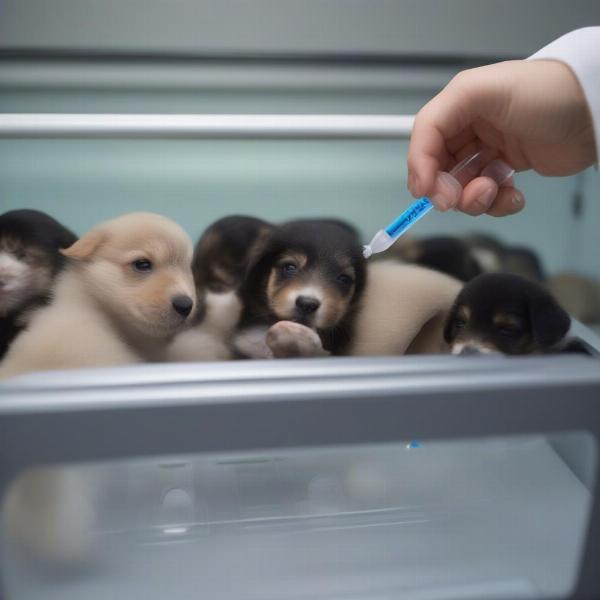Dog incubators, also known as neonatal puppy incubators, play a crucial role in providing life-saving warmth and care for newborn puppies, especially those born prematurely, orphaned, or struggling to thrive. These specialized devices mimic the warmth and humidity of a mother dog’s den, offering a safe and controlled environment for vulnerable puppies to develop and grow. Understanding how to use a dog incubator correctly can be the difference between life and death for these fragile lives.
Why Use a Dog Incubator?
A dog incubator provides a consistent temperature and humidity level, crucial for newborn puppies who cannot regulate their body temperature effectively. This is particularly important for puppies born prematurely or those experiencing difficulties nursing. An incubator can also provide isolation for sick puppies, preventing the spread of illness to their littermates. It becomes indispensable for orphaned puppies, replacing the essential warmth and humidity they would normally receive from their mother. This controlled environment allows for close monitoring and individualized care, ensuring each puppy receives the support it needs to thrive.
Choosing the Right Dog Incubator
Selecting the right dog incubator involves considering several factors. Size is crucial, as the incubator should accommodate the number of puppies comfortably without overcrowding. Features such as adjustable temperature and humidity controls, oxygen ports, and nebulizer attachments are vital for providing optimal care. Portability can be beneficial if you need to transport the puppies or move the incubator within your home. Finally, cost is a factor, with basic models offering essential functionalities and more advanced options including additional features. Researching different brands and models and reading reviews can help you make an informed decision based on your specific needs and budget.
Setting Up and Maintaining a Dog Incubator
Proper setup and maintenance are essential for the incubator’s effectiveness. Start by thoroughly cleaning and disinfecting the incubator before introducing the puppies. Place a soft, absorbent bedding material inside to provide comfort and absorb any accidents. Carefully monitor and adjust the temperature and humidity levels according to the puppies’ age and condition. Regular cleaning and disinfection are essential to prevent bacterial growth and maintain a hygienic environment. Proper ventilation is also crucial to ensure fresh air circulation and prevent the buildup of carbon dioxide.
Monitoring Puppies in an Incubator
 Monitoring Puppies in Incubator
Monitoring Puppies in Incubator
Regular monitoring is paramount when using a dog incubator. Observe the puppies’ breathing, activity levels, and body temperature. Weigh the puppies daily to track their growth and ensure they are gaining weight appropriately. Look for signs of dehydration, such as dry gums and sunken eyes. Any abnormalities should be reported to your veterinarian immediately. Maintaining detailed records of the puppies’ progress can help identify potential problems early on and facilitate effective intervention.
When to Seek Veterinary Advice
While a dog incubator can be a life-saver, it is not a substitute for professional veterinary care. If you notice any signs of illness or distress in your puppies, contact your veterinarian immediately. These signs could include labored breathing, lethargy, vomiting, diarrhea, or failure to gain weight. Your veterinarian can diagnose the problem and provide appropriate treatment and guidance.
Conclusion
Dog incubators are essential tools for providing life-saving care to vulnerable newborn puppies. Understanding how to choose, set up, and maintain an incubator correctly can make a significant difference in their survival and development. By closely monitoring the puppies and seeking veterinary advice when needed, you can ensure these fragile lives have the best chance to thrive. Remember, an incubator provides a supportive environment, but consistent care and observation are crucial for the puppies’ overall well-being.
FAQ
-
How often should I clean a dog incubator? Clean and disinfect the incubator thoroughly every 24-48 hours to maintain hygiene.
-
What temperature should I set the dog incubator to? The ideal temperature for newborn puppies is generally between 85-90°F (29-32°C). Adjust as they grow.
-
Can I use a human incubator for puppies? No, human incubators are not designed for puppies and may not provide the correct temperature and humidity levels.
-
What bedding should I use in a dog incubator? Use soft, absorbent bedding that can be easily cleaned and replaced.
-
How often should I monitor puppies in an incubator? Monitor puppies regularly, at least every 2-4 hours, especially in the early days.
-
When can I remove puppies from the incubator? Puppies can typically be removed when they can consistently maintain their body temperature, usually around 3-4 weeks of age. Consult your vet.
-
Where can I purchase a dog incubator? Dog incubators can be purchased from veterinary supply stores, pet stores, and online retailers.
ILM Dog is your trusted partner in dog care, offering expert advice and resources on all aspects of canine health, nutrition, behavior, and well-being. From breed selection to senior dog care, we provide comprehensive information to empower dog owners worldwide. Contact us today at [email protected] or +44 20-3965-8624 for personalized support and guidance. ILM Dog understands the unique needs of every dog and is committed to providing you with the knowledge and tools necessary to ensure your furry friend enjoys a long, healthy, and happy life.